 |
霧島神宮・境内マップ 目指して、観光をしました。 神宮公式 サイト : ★ Kirishima-jingu Shrine Precinct Guide Map in Japanese From 26th of September to 1st of October Today, on the 29th, we went sightseeing Kagoshima Kotsu Taxi's driver, S San. This section is about 'Kirishima-jingu Shrine - Worship'. The Shrine official website : ★ only in Japanese 画像は下記より / These from below |
目次 / Contents
1) 手水舎と龍 / Chōzu-ya And Dragon
2) 国歌の歌詞 / National Anthem Lyrics
A. さざれ石の碑 / Sazare-ishi Monument
B. さざれ石の展示 / Display of Sazare-ishi
3) 本殿まで/ To the Main Shrine
A. 三の鳥居 / San-no-Torii Gate
B. 正面 / Facade
C. 需要文化財と国宝 / Important Cultural Property and
National Treasures
D. 祭神 / Enshrined Deities
E. 植物 / Plants
4) 御神木神職 / Go-Shinnboku-Shinshoku
5) 参拝後 / After Worship
1) 手水舎と龍 / Chōzu-ya And Dragon
今までの霧島神宮については下記。
About Kirishima-jingu Shrine to now, below.
In front of the third torii gate just before worship, there is a Chōzu-ya and 'Sazare-ishi' stones : Map ❹.
 |
| 手水舎 手水舎が好きです。 これから参拝するにあたっての軽い緊張感が心地よく感じます。 自分を清められる機会を得られること、 龍好きなので、多くの手水舎で龍が見られること が嬉しいです。 Chōzu-ya Chōzu-ya is a Shinto water ablution pavilion for the ceremonial purification rite. It is a place where you wash your hands and rinse your mouth at a shrine. Moreover, the act makes purification of your spirit, officially. I like chōzu-ya. I feel comfortable with the light tension of visiting the shrine. I am happy to have the opportunity to purify myself, and since I am a dragon lover, I am happy to see dragons in many chōzu-ya. |
 |
| コロナを考慮 多くの神社、仏閣でコロナのために手水舎は 使用禁止になっていました。 最近は使用開始されてきています。 ここでは以前と場所とあり方が変わっています。 この変化がコロナ前後なのかは正確にはわかりません。 以前は三の鳥居を過ぎ本殿前: 地図 ❸に ありましたが、今は三の鳥居の前にあります。 神様にコロナウイルスを近づけないためでしょうか? 下の写真のように、以前は水が開放され、 ひしゃくがついていました。 Considering Corona Many shrines and temples have banned the use of chōzu-ya because of the coronavirus. Recently, many have come back into use. Here, it's in a different place and format than it used to be. I don't know exactly if these changes are pre- or post-Corona. It used to be in front of the main shrine after the third torii gate : Map ❸, but now it is in front of the third torii gate. Is this to keep the coronavirus away from Gods? Previously, the water was open and ladles were used, as shown in the photograph below. |
 |
| 以前の手水舎 / Forner Chōzu-ya 画像は下記より / This from below ★ |
<補足>
初代天皇・ 神武天皇 (ジンムテンノウ /711 BC or 721 BC - 585 BC / 在位 : 660 BC – 585 BC) の祖母、 豊玉姫尊 (トヨタマヒメノミコト) は、 海神 (ワタツミ) : 海龍神の娘でした。
ちなみに、祖父の方は、 彦火火出見尊 (ヒコホホデミノミコト) 、
よく知られた名前は、山幸彦です。
日本の皇室には、龍神の血が流れているのです。
神話って素敵ですね。
<Supplement>
Toyotama-hime : Toyotama-hime Goddess, the grandmother of the first emperor Emperor Jimmu (711 BC or 721 BC - 585 BC / Reign : 660 BC – 585 BC), was the daughter of Watatsumi, Sea God : Sea Dragon God.
By the way, his grandfather was Hoori, better known as Yamasachihiko.
The blood of the dragon god runs through the Japanese Imperial family.
Mythology is wonderful.
2) 国歌の歌詞 / National Anthem Lyrics
A. さざれ石の碑 / Sazare-ishi Monument
そのうえ、神社での その'碑' となれば、なおのことです。
想像通り、そこには、君が代の歌詞に詠まれている石として、'さざれ石' の説明が書かれています。
下記の太字が、この碑文にかかれている内容です。
"国歌に詠まれている「さざれ石」
この石は学名を石灰質角礫岩 (ササマタノセッカイシツカクレキキョガン) と云う。
石灰石が雨水に溶解してその石灰分をふくんだ水が時には粘着力の強い乳状体となり、地下において小石を集結して次第に大きくなる。
やがてそれが地上に顕れて国歌に詠まれる如く、千代八千代 年をへてさざれ石巌となりて苔のむすと云う状は、実に目出度いかぎりである。
上記文章は昭和三十七年文部省の中庭に贈呈された「さざれ石」の木札に記されたものと同文であり、国歌に詠まれている「さざれ石」については岐阜県揖斐川町出身の故小林宗一 (号宗閑) 氏によって発見解明されました。"
国歌は、何度となく歌ってきましたが、初めて知った内容でした。
若かりし頃は、我が国の国歌を歌うことを拒否したこともありましたが、今は、拒否感はもっていません。
皮肉なことに?、拒否感がなくなった今では、国家を歌う機会がなく、若い頃よりも歌っていません。
 |
| さざれ石の碑と実際のさざれ石 Sazare-ishi Monument and Actual Sazare-ishi Stones  さざれ石の碑 / Sazare-ishi Monument |
Sazare-ishi Monument
The original meaning of 'Sazare-ishi' is pebble(s) or fine stone, but for Japanese people, the first thing that comes to mind is the use of the word in the Kimigayo', national anthem, rather than the original meaning.
Moreover, if 'Sazare-ishi' name becomes the a 'monument' at the shrine, all the more so.
As I can imagine, there is a reference to 'Sazare-ishi' as the stone mentioned in the Kimigayo's lyrics.
The text in bold below is what is written in this inscription.
(Translated by me)
"The 'Sazare-ishi' is Used in the National Anthem
The scientific name of this stone is calcareous breccia.
Limestone dissolves in rainwater, and the calcareous water sometimes forms a highly adhesive emulsified body, which gathers pebbles underground and gradually grows larger.
It eventually appears on the ground, and just as it is written in the national anthem, after thousands of years it has become a stone rock and covered with moss.
This stone was discovered in the mountains in Kasuga, Ibi District, Gifu, which is said to be the birthplace of the national anthem.
The above sentence is the same as the one written on the wooden tag of 'Sazare-ishi' which was gifted to the courtyard of the Ministry of Education in 1962 and 'Sazare-ishi' was discovered and clarified by the late Souichi Kobayashi."
I have sung the national anthem many times, but this was the first time I found out about this story, above.
When I was young, sometimes I used to refuse to sing our national anthem, but now I don't feel any refusal.
Ironically? , now that the feeling of rejection is gone, I have no chance to sing national songs, and I sing less often than when I was young.
 |
| 文部省・中庭のさざれ石 この写真の木札の文章が霧島神宮のさざれ石の説明に 使用されています。 Sazare-ishi in the Courtyard, Ministry of Education The text on the wooden tag in this photograph is used to describe the Sazare-ishi in Kirishima-jingu Shrine. 画像は下記より / This from below ★ |
B. さざれ石の展示 / Display of Sazare-ishi
'さざれ石の碑' のそばに、実際の 'さざれ石' が2つ設置 (展示) されています。
私は、当初、それを見た時に、わずかばかり、動揺しました。
君が代の歌詞では、かなり壮大なイメージがあり、実物のさざれ石がうまく結びつかず、まさかこれが!と信じられない気持ちが先行しました。
Wikiでは、
知られている。
ただし、歌詞中のさざれ石(細石)は文字通り、細かい石・小石の
意であり、それらの小石が巌(いわお)となり、さらにその上に苔が生えるまでの過程が、非常に長い歳月を表す比喩表現として用いられている。"
とあります。
この 'よみ人知らず' さんは、展示してある 'さざれ石' を詠んでいたのではないと思われます。
私が抱いていたイメージは、想像の産物でしたが、それは歌詞の役割からすれば、好ましいのではないかと思います。
実際の展示も、こうして展示してあれば、こんな感じなのね〜という理解の助けになったり、話題としての面白さにもなったりすると思います。
 |
さざれ石 / Sazare-ishi 奉納者は3名で、そのうちの一人は、'さざれ石'の 発見者、故 小林宗一 ( コバヤシ ソウイチ / 1891 - 1969) 氏の 息子、小林 文治 (1924~) さんで、彼はここだけでなく、全国各地 で 'さざれ石' が実在する石であることを知らせるために この活動をしていると聞きました。 全国に神社やそのほか、 'さざれ石' が展示されているのは、 40以上もあるそうです。 さざれ石 / Sazare-ishi I heard that there are three people who donated these particular stones, one of them is Bunji Kobayashi (1924~), the son of Souichi Kobayashi (1891 - 1969), who discovered the 'Sazare-ishi' and he did this activity to let people know that 'Sazare-ishi' are real stones throughout Japan. It seems that there are more than 40 shrines and other places where 'Sazare-ishi' are displayed in Japan. |
 |
| さざれ石 手前のさざれ石にはコインが置かれています。 お賽銭的な感覚で、人々は置くのでしょうか? Sazare-ishi Coins are placed on this side of the stone. Do people place them like an offering? |
Display of Sazare-ishi
Two actual 'Sazare-ishi' are installed (exhibited) beside the 'Sazare-ishi Monument'.
I was slightly upset when I first saw them.
For me, Kimigayo's lyrics have a rather grandiose image, and the real 'Sazare-ishi' didn't connect well, so this is it! my feeling of disbelief preceded me.
According to Japanese Wiki (translated by me),
"The word is known because it is sung in the lyrics of "Kimigayo", the national anthem of Japan.
However, the Sazare-ishi in the lyrics literally mean fine stones and pebbles, and the process of turning those pebbles into rocks and then growing moss on top of them is used as a metaphorical expression that expresses a very long period of time."
Kimigayo's lyric is based on the Waka (Japanese classical poem) by 'Yomihito Shirazu' (anonymous) from "Kokin Wakashū" (Heian Period / 794 - 1185).
I don't think this 'anonymous' composed the Waka thinking of the 'Sazare-ishi' as being like these on display.
However, if 'Sazare-ishi' are displayed like these, I think it will help our understanding what 'Sazare-ishi' looks like, and it will be an interesting topic.
3) 本殿まで / To the Main Shrine
A. 三の鳥居 / San-no-Torii Gate
 |
| 三の鳥居とY 三の鳥居の右側に'さざれ石の碑'と'さざれ石'があります。 写真右奥に本殿が見えます。 San-no-Torii Gate and Y On the right side of the third torii gate, there is the 'Sazare-ishi' Monument and the 'Sazare-ishi'. The main shrine can be seen far away in the right of the photograph. |
B. 正面 / Facade
霧島神宮は、540年創設以来、噴火による火災の災難で、場所も建物も変わっています。
島津 吉貴 (シマズ ヨシタカ / 1675 - 1747 / 在任 : 1704 - 1721) が1715年に建て、寄進したものです。
社殿については下記。
本殿正面から撮影したのは、下の写真のみです。
この旅行の少し前に、神社の近くからの真正面の写真は神様に失礼であると聞いたからです。
今まで数多くそうした写真を撮ってきたのに、何をいまさらと自分でも思います。
ですが、知ってしまい、それを気にしているなら、しないほうが自分の精神上良いと思ってしませんでした。
ですが、将来、また撮影し始めるかもしれません。
 |
| 社殿 / Main Shrine 地図 ❶ / Map ❶ |
Facade
Since its foundation in 540, Kirishima-jingu Shrine changed its location and buildings due to fire disasters caused by eruptions.
The current Shrine building was built in 1715 and donated by Yoshitaka Shimazu (1675 - 1747 / reign : 1704 - 1721), the 21st head of the Shimazu Clan and the 4th Lord of the Satsuma Domain.
About the Shrine buildings, below.
This, above is the only photograph taken from the front of the main shrine.
Because I heard a little while before this trip that a photograph taken directly from near the shrine would be disrespectful to Gods.
I have taken many such photographs, I think of myself before and what I am saying now.
However, if I knew about it and I care about it, it would be better for my mental health not to do it.
But I may start photographing again in the future.
 |
勅使殿 真ん中が勅使殿、両脇に 門守神社 (カドモリジンジャ) があります。 勅使殿の奥に本殿があります。 この画像は神宮のサイトからダウンロードしたものです。 本殿の説明はこちら→★ Chokushi-den In the middle is the Chokushi-den, and on both sides are Kadomori Shrines. There is a main hall behind the Chokushi-den. This image was downloaded from the Jingu website. |
C. 需要文化財と国宝
Important Cultural Property and
National Treasures
実は、現地にいた時には、勅使殿が本殿だと思い、参拝しました。
奥に建物がいくつかあるのは、気がついていましたが、それらが本殿・幣殿・拝殿であり、勅使殿が拝殿と登廊下で繋がっていることなど知りませんでした。
2022年2月に国宝指定を受けていたことも知りませんでした。
帰宅後、霧島神宮の屋内が、極彩色に装飾され、その上、私が大好きな龍が阿吽の形で柱になっていることを知り、驚きました。
まあ、それらを知って参拝したとしても、できることは同じですが...。
 |
| 境内と勅使殿 一般参拝は勅使殿でします。 勅使殿は重要文化財に指定されています。 Precincts and Chokushi-den General worship is held at the Chokushi-den. The Chokushi-den is designated as an Important Cultural Property.  緑に囲まれていますね。 It's surrounded by greenery. |
一般の参拝者は、勅使殿の前から、参拝し、その奥へは入れません。
2022年2月に本殿・幣殿 (ヘイデン)・拝殿が国宝に指定されましたが、それらは通常見ることができません。
霧島神宮の重要文化財の建物は、1989年5月に指定されました。
春と秋に、'特別拝観' が日時限定、必須予約であるようです。
'特別拝観'でどこまで見られるのでしょうか?
本殿・幣殿・拝殿などの画像をネットで検索し、ここに載せます。
 |
| 勅使殿 / Chokushi-den 画像は下記より / This from below ★ |
Important Cultural Property and
National Treasures
In fact, when I was there, I thought that the Chokushi-den was the main hall, and I worshiped.
I noticed that there were some buildings behind, but I didn't know that they were the main hall, hei-den, and hai-den, and that the Chokushi-den was connected to the hai-den by the climbing corridor.
I didn't even know that the three halls were designated as National Treasures in February 2022.
After returning home, I was surprised to find that the interior of the Shrine was decorated in rich colours and that dragons, my favourite creatures are used as pillars in the shape of A-un.
Well, even if I had known of them and would visit them, I still could only do the same thing...
General worshipers worship from the front of the Chokushi-den and cannot enter further.
In February 2022, the main hall, hei-den, and hai-den : worship hall were designated as National Treasures, but they cannot normally be seen.
The buildings in Kirishima-jingu Shrine were designated as Important Cultural properties in May 1989.
In spring and autumn, they have limited 'special visits' which must be reserved.
How much can we see in the 'special visit'?
I researched the internet for images of the main hall, hei-sen, hai-den, etc., and show them here.
 |
| 私はこの案内板を見ませんでした。 赤枠部分が国宝指定の建物です。 A Part of Information Board I didn't see this information board. The buildings framed in red are designated as National Treasure in Japan. 画像は下記より/ This from below ★ |
 |
| 下記、'カゴシママガジン': ★より "霧島山から噴出した溶岩が当地域まで流れてきており、 その溶岩流でできた傾斜を巧みに利用して、 本殿・幣殿・拝殿・登廊下・勅使殿を一直線に配しています。" According to Kagoshima Magazine Website': ★, (translated by me) "The lava that erupted from Mt. Kirishima flowed into this area, and the main hall, hei-den (offering hall), Hai-den (worship hall), Climbing Corridor, and Chokushi-den are arranged in a straight line making good use of the slope created by the lava flow. " 画像は下記より / This from below ★  登廊下 (重要文化財) 勅使殿 (左) と拝殿 (右) を繋いでいます。 一般参拝者は、勅使殿 からこの廊下に向かって 頭を下げています。 ちょっと滑稽と思うのは、私だけでしょうか? 私達の思いは、この廊下を駆け上り 本殿祭壇へ到達すると信じたいです。 Climbing Corridor (Important Cultural Propery) It connects the Chokushi-den (the left ) and the Hai-den : Worship Hall (the right). General worshipers bow their (our) heads towards this Corridor from the Chokushi-den. Am I the only one who thinks this is a little funny? I would like to believe that our thoughts run up this Corridor and reach the main altar. 画像は下記より / This from below ★  登廊下 / Climbing Corridor 画像は下記より / This from below ★ |
'カゴシママガジン'のサイトでは、霧島神宮の建物について、素敵にまとめられています→★
The website of 'Kagoshima Magazine' has a lovely summary of the buildings of Kirishima-jingu Shrine.→★ only in Japanese.
 |
| 拝殿殿 (重要文化財及び国宝) 登廊下の先に拝殿があります。 Hai-den (Important Cultural Property and National Treasures) There is the Hai-den : Worship Hall at the end of the Climbing Corridor. 画像は下記より / This from below ★ |
 |
| 幣殿・本殿 本殿前には、極彩色に施され、彫られた 阿吽の龍柱が瑞雲 (ズイウン) とともにあります。 画像で見ただけで、圧倒されます。 龍の阿吽 (アウン) 形があることを初めて知りました。 嬉しい驚きです。 龍柱は鹿児島地方特有のものだそうです。 '特別拝観'に参加できると、ここを実際に見られます。 画像元は霧島市教育委員会で、 私は、'カゴシママガジン'のサイトから借りています。 Hei-den・Main Hall In front of the main hall, there are richly colored and Just by looking at the image, I am overwhelmed. I learned for the first time that there is an A-un form of dragon. Pleasantly surprised. Dragon pillars are said to be unique to the Kagoshima region. If you can participate in the 'special visit', you could actually see this place. The source of the image is the Kirishima City Board of Education, and I borrow this from the 'Kagoshima Magazine' website. |
幣殿は、拝殿と本殿の間にあり、本来は、奉納品を渡す場所です。
拝殿の先、階段上に本殿祭壇があります。
私には、幣殿と本殿の境がどこなのかわかりません。
 |
| 阿吽の龍柱 右が阿、左が吽の龍です。 その奥に"琴棋書画の絵" があります。 A-un Dragon Pillars The dragon on the right is A, and the dragon on the left is Un. 画像は下記より / This from below ★ |
 |
| "琴棋書画" 琴棋書画 (キンキショガ) は、琴と碁と書と画のことで、 文人として行う風流な遊びです。 この"琴棋書画の絵" は龍柱と祭壇の間の天井近くにあります。 "Kinkishoga : Four Arts" Kinkishoga : Four Arts is a pastime of Guqin, Go, Calligraphy, and Painting, and is an elegant game played by literati. This "Four Arts Painting" is near the ceiling between the dragon pillars and the altar. 画像は下記より / This from below ★ |
The Hei-den is located between the Hai-den and the main hall, and was originally a place to hand over offerings.
There is a main altar at the top of the stairs at the end of the Hai-den.
I don't know where the boundary between the Hei-den and the main hall is.
 |
| 階段上の風景 ここが本殿の祭壇ですよね? View on the Stairs This is the main altar, right? 画像は下記より / This from below ★ |
 |
| 本殿前室の外陣 床は、鶯張 (ウスイスバリ) です。 床を歩く者がいると音を発し、鴬の鳴くような音が聞こえ、 夜間など侵入者があればすぐに分かる、一種の警報装置。 こんな音→★ 鶯張の詳細はここで→★ Outside of the Front Room of the Main Hall The floor is Uguisubari : it can be said to be a kind of alarm device that emits a sound when someone walks on the floor, and you can hear a sound similar to the chirping of Uguisu ; Japanese Bush Warbler. It sounds →★ 画像は下記より / This from below ★ |
本殿の壁画 / Murals in the Main Hall
 |
| "二十四孝図" 本殿の壁には、24の孝子説話 (コウシセツワ) が描かれています。 一般公開されていません。 "Pictures of Twenty - Four Filial Piety" On the walls of the main hall, there are 24 stories about filial piety. Not open to the public. 画像は下記より / This from below ★ |
 |
| '霧島神宮の栞'より Murals in the Main Hall From 'leaflet of Kirishima-jingu Shrine' |
 |
| 壁画と彫刻 / Murals and Sculpture 画像は下記より / This from below ★ |
本殿・幣殿・拝殿・登廊下・勅使殿と建物の名前はありますが、
これらをまとめて、本殿ととらえるのが通常の理解なのではないかと、さいごになって思いました。
Although there are names for buildings such as the Main hall, Hei-den, Hai-den the Climbing Corridor, and Chokushi-den, I finally thought that the general understanding would be to collectively consider them as the main hall.
D. 祭神 / Enshrined Deities
 |
| 祭神の説明板 霧島神宮の現在の祭神は、7柱 (ナナハシラ)です。 主祭神は、 天饒石国饒石天津日高彦火瓊瓊杵尊 (アメニギシクニニギシアマツヒタカヒコホノニニギノミコト) 瓊瓊杵尊 (ニニギノミコト) です。 Explanation Board of the Enshrined Deities The current enshrined deities of Kirishima-jingu Shrine are the seven Gods The main enshrined deity is Ninigi no Mikoto. |
天真降臨、祭神 については下記。
About Tenson-kōrin and Enshrined Deities below.
霧島神宮祭神
The Enshrined Deities of Kirishima-jingu Shrine
| 天照大神Amaterasu | 高皇産霊尊 Takamimusubi | ||||||||||||||||||||||||||||||||||
| 天忍穂耳尊 Ame-no-oshihomimi | 栲幡千千姫命 Takuhadachiji-hime | (天神) | 大山祇神 Ōyamatsumi | ||||||||||||||||||||||||||||||||
| 1) 瓊瓊杵尊 Ninigi-no-Mikoto (天孫) | 2) 木花開姫尊 Konohanasakuya-hime | 豊玉彦命 Watatsumi (海神) | |||||||||||||||||||||||||||||||||
| 火闌降命 Hosuseri (海幸彦) | 3) 火折尊 Hoori (山幸彦) | 4) 豊玉姫尊 Toyotama-hime | 宇都志日金拆命 Utsushihikanasaku | ||||||||||||||||||||||||||||||||
| (子孫は隼人) Hayato people | 5) 鸕鶿草葺不合尊 Ugayafukiaezu | 6) 玉依姫命 Tamayori-hime | (子孫は阿曇氏) | ||||||||||||||||||||||||||||||||
| 五瀬命 | 稲飯命 | 三毛野命 | 7) 磐余彦尊 Jimmu (神武天皇) | ||||||||||||||||||||||||||||||||
| (子孫は皇室) Imperial House of Japan | |||||||||||||||||||||||||||||||||||
E. 植物 / Plants
石と木の柵が本殿の周囲を囲み、一般参詣者は、正面と右から中へ入ることができます。
私達は、S さんに案内され、正面から入らず、正面から右におれ、柵 (壁?) の外側に沿って歩きました。
S さんがいなければ、私たちはきっと正面から直接本殿に向かったと思います。
 |
| 左側に進むと本殿、私達は、柵 (壁) 沿いのここを進みました。 If we go to the left, we would see the main shrine, but we went alongside the wall. |
Plants
Stone and wooden fences surround the main shrine, and general pilgrims can enter from the front and right.
We were guided by S San, and instead of entering from the front, we went to the right from the front and walked along the outside of the fence.
If S San was not there, I'm sure we would have headed straight to the main shrine.
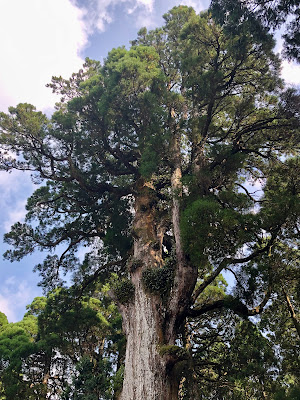 |
私は、木が好きです。 ここにはたくさんの巨木があります。 木々の中の空間は、とても気持ちが良いです。 本殿は、こうした木々の中に建っています。 I like trees There are many big trees here. The space in the trees is very comfortable. The main shrine is built among these trees. |
 |
| シホウチク ( 四方竹) を初めて見ました。 タケノコは秋から冬に生えてくるのが、珍しく感じます。 日本では枝を出さずに越年し、春暖くなったときに枝を広げます。 Tag of Chimonobambusa Quadrangularis (Square Bamboo) I saw Shihouchiku : Square Bamboo for the first time. It is unusual for bamboo shoots to grow from autumn to winter. In Japan, it grows over the year without putting out branches, and spreads its branches when it gets warm in spring. |
竹が四角い様を記録しようと動画を撮りましたが、
私の技術不足で竹の四角さを明確にお見せできません。
すみません...。
話し声はYとSさんです。
Sさんがタケノコが秋に生えてくることを説してくれました。
I took a video to record the squareness of the bamboo,
but due to my lack of skill, I was unable to clearly show
the squareness of the bamboo.
I am sorry....
The speaking voices are Y and S San.
S San explained that the bamboo shoots grow in autumn.
 |
| マムシグサ マムシグサ (蝮草)の実を初めてみました。 おもしろい形です。 毒性があるので、この怖そうな名前がついたのでしょうか? Arisaema Serratum : Mamushi-gusa This is the first time I've seen the fruit of Arisaema Serratum : Mamushi-gusa in Japanese. Mamushi means Gloydius Blomhoffii, one of snakes and gusa means grass. Interesting shape. Is it because of its toxicity that it got this terrifying name? |
4) 御神木神職 / Go-Shinnboku-Shinshoku
Sさんが私達を脇道に案内した目的は、御神木神職 (ゴシンボクシンショク) を見せるためでした。
The purpose of S San leading us to the side path was to show the sacred tree priest : Go-Shinboku- Shinshoku.
According to Wiki about (Go) Shinboku,
A shinboku (神木) is a tree or forest worshipped as a shintai – a physical object of worship at or near a Shinto shrine, worshipped as a repository in which spirits or kami reside.
~
The related term goshingi refers to trees that are considered sacred or divine in the precincts of Shinto shrines and jingū of Shinto, as well as the forests that surround them and trees that are not grown for logging."
 |
| 説明版 "御神木の枝木が装束をつけた人が参拝している様に見えます。" Explanation Board According to the Explanation (Translated by me) "The branche of the sacred tree look like person wearing costumes are worshiping".  なるほど〜〜! Indee~d! |
 |
| ③ 御神木 '霧島神宮の栞'より ③ Go-Shinboku From 'leaflet of Kirishima-jingu Shrine' |
木が大き過ぎて、写真ではすべてを撮影できないので、
動画で撮影しました。
(5秒)
The tree is too big to capture everything in a photograph,
so I took a video.
(5 seconds)
御神木 / Go-Shinboku

5) 参拝後 / After Worship
 |
| 屋根 社殿の屋内は見ることができません。 屋根を見ることができ、撮影しました。 千木 (チギ) が2種類あるのは知っていますが、 いつもどちらなのかは判断がつきません。 Roof The interior of the shrine cannot be seen. I could see the roof and photographed. I know there are two kinds of Chigi, but I always can't tell which is which. |
 |
| 千木・内削ぎ 霧島神宮はこちらの千木でした。 Chigi・Horizontal Cutting Kirishima-jingu Shrine uses Chigi this way.  千木・外削ぎ Chigi・Vertical Cutting 画像は下記より / These from below ★ |
 |
| 参拝を済ませて、山神社(左)へ向かいました。 S さんは、三の鳥居で待っていました。 神楽殿(右)は見ていません。 After paying our respects, we headed to the Mountain Shrine on the left. S San was waiting for us at the third torii gate. We didn't see Kagura-den on the right. |
 |
| 山神社への道 Road to Mountain Shrine |
次のセクションは、山神社と亀石についてです。
The next section is about the Mountain Shrine and Kameishi : Turtle Stone.

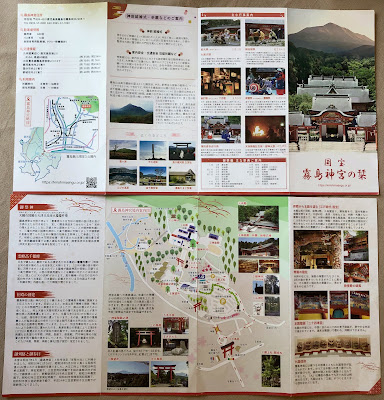

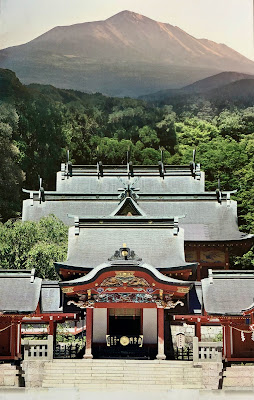



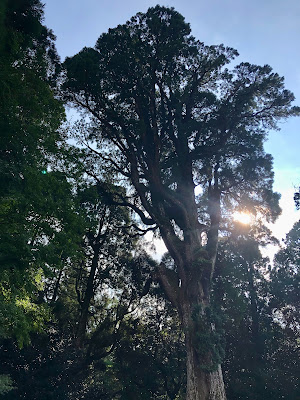


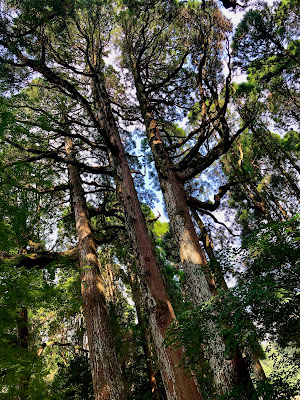
0 件のコメント:
コメントを投稿